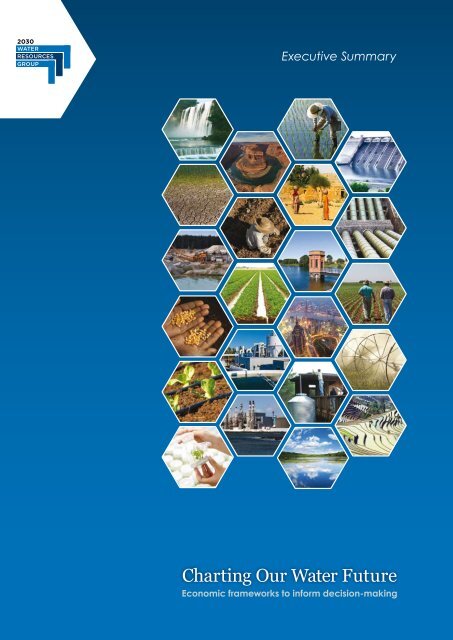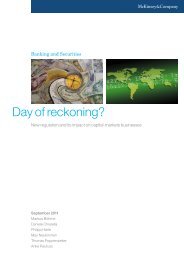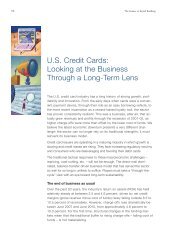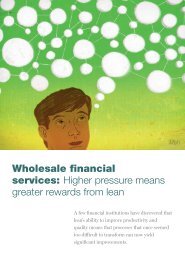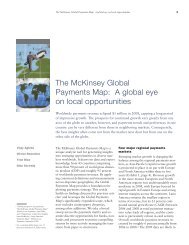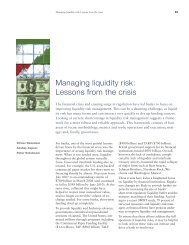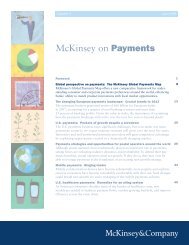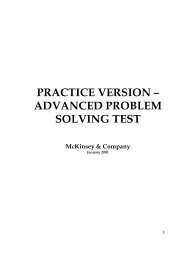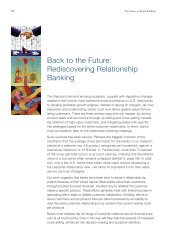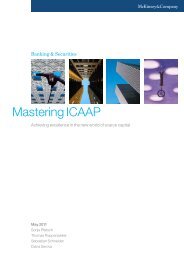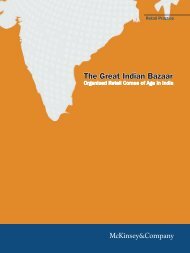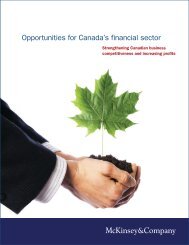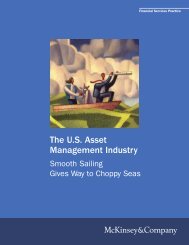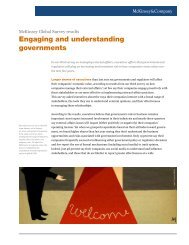Charting Our Water Future - McKinsey & Company
Charting Our Water Future - McKinsey & Company
Charting Our Water Future - McKinsey & Company
- No tags were found...
You also want an ePaper? Increase the reach of your titles
YUMPU automatically turns print PDFs into web optimized ePapers that Google loves.
1Executive Summary<strong>Charting</strong> <strong>Our</strong> <strong>Water</strong> <strong>Future</strong>Economic frameworks to inform decision-makingEconomic frameworks to inform decision-making
3The 2030 <strong>Water</strong> Resources GroupThe 2030 <strong>Water</strong> Resources Group was formed in 2008 to contribute new insightsto the increasingly critical issue of water resource scarcity. The group aimed to create anintegrated fact base on the potential technical levers and costs for reducing water scarcity,with the ultimate goal of advancing solutions-driven dialogue among stakeholders.The Group consists of a range of organizations from the private and social sectors, whichprovided the institutional collaboration and counsel needed to tackle this complex topic:• Initiating sponsorship for the project came from The International FinanceCorporation (IFC), part of the World Bank Group, which provides investmentsand advisory services to build the private sector in developing countries. The WorldBank also provided substantial input from its experience in the water sector.• <strong>McKinsey</strong> & <strong>Company</strong>, a global management consulting firm, provided overallproject management, drove the analytical execution and developed the fact basefor the report.• An extended business consortium provided sponsorship, guidance, andexpertise. This included: The Barilla Group, a global food group; TheCoca-Cola <strong>Company</strong>, a global beverage company; Nestlé S.A., a globalnutrition, health, and wellness company; SABMiller plc, a global brewer; NewHolland Agriculture, a global agricultural equipment company; StandardChartered Bank, a global financial institution, and Syngenta AG, a globalagribusiness.Economic frameworks to inform decision-making
Economic frameworks to inform decision-making5
6ForewordHis Royal Highness the Prince of Orange, Chairman of the United NationsSecretary-General’s Advisory Board on <strong>Water</strong> and SanitationWhen I chaired the Second World <strong>Water</strong> Forum in The Hague in 2000, I set out a simple mission:to make water everyone’s business. I am therefore gratified that the 2030 <strong>Water</strong> ResourcesGroup—a consortium of mostly private companies from several important sectors of the worldeconomy—has made it their business to put together this report. And indeed, the report’s centralmessage is that any strategy to achieve water resource security must be a joint effort—integratedwith broader economic decision-making—by governments, investors, NGOs, and water users inagriculture, industry and cities.The picture shown by the report is certainly sobering: The ever-expanding water demand of theworld’s growing population and economy, combined with the impacts of climate change, arealready making water scarcity a reality in many parts of the world—and with it we are witnessingsevere damage to livelihoods, human health, and ecosystems. In just 20 years, this report shows,demand for water will be 40 percent higher than it is today, and more than 50 percent higherin the most rapidly developing countries. Historic rates of supply expansion and efficiencyimprovement will close only a fraction of this gap. Unless local, national and global communitiescome together and dramatically improve the way we envision and manage water, there will bemany more hungry villages and degraded environments—and economic development itself willbe put at risk in many countries.Encouragingly, though, the report also finds that the future “water gap” can be closed. Evenin rapidly developing, water-scarce countries, there is a set of measures—to boost efficiency,augment supply, or lessen the water-intensity of the economy—that in principle could meethuman and environmental water needs at affordable cost. The report shows how “crop per drop”can be increased dramatically in agriculture, which today consumes 70 percent of the world’swater. This has also been the message the United Nations Secretary-General’s Advisory Boardon <strong>Water</strong> and Sanitation has kept on conveying to decision-makers: that water requires morepolitical attention and strategic thinking.What this report provides, however, is a toolkit that stakeholders can use to compare the impact,cost and achievability of a range of different measures and technologies, so providing the factbase needed to underpin solutions.<strong>Charting</strong> <strong>Our</strong> <strong>Water</strong> <strong>Future</strong>
7If water is to be everyone’s business, then stakeholders will need to come together in water-scarcecountries to make some difficult trade-offs on the road to water resource security. Some solutionsmay require potentially unpopular policy changes and the adoption of water-saving techniquesand technologies by millions of farmers. The conversation needed amongst stakeholders, then,is about a country’s economic and social priorities, what water will be needed to meet thosepriorities, and which difficult challenges are worth tackling to deliver or free up that water. Thisreport’s contribution is to create a common economic language which all stakeholders can use inparticipating in that conversation.Of course, this report will have failed if it sparks no more than conversation. The fact base,frameworks and insights presented here must galvanize action. I therefore urge stakeholdersin every country to apply the tools in this report to their own water challenges, bringingpolicymakers together with the private and social sectors to identify and implement solutions touse our most precious resource much more wisely and effectively.HRH The Prince of Orange Willem-AlexanderChairman of the United Nations Secretary-General’sAdvisory Board on <strong>Water</strong> and SanitationEconomic frameworks to inform decision-making
8<strong>Charting</strong> <strong>Our</strong> <strong>Water</strong> <strong>Future</strong>
9PrefaceThe world is increasingly turning its attention to the issue of water scarcity. Many countriesface water scarcity as a fundamental challenge to their economic and social development; by2030 over a third of the world population will be living in river basins that will have to copewith significant water stress, including many of the countries and regions that drive globaleconomic growth.Across the globe, policy makers, civil society and the business sector are increasinglybecoming aware of the challenge facing global water resources, and the need to carefullymanage these resources. Progress has been limited, however, and overall too slow. Onemissing piece has been the lack of a rigorous analytical framework to facilitate decision-makingand investment into the sector, particularly on measures of efficiency and water productivity.The report <strong>Charting</strong> <strong>Our</strong> <strong>Water</strong> <strong>Future</strong> was developed to take a first step in providing greaterclarity on the scale, costs and tradeoffs of solutions to water scarcity. It is the result of a year-longcollaboration involving IFC (a member of the World Bank Group), <strong>McKinsey</strong> & <strong>Company</strong>,The Coca-Cola <strong>Company</strong>, Barilla, New Holland Agriculture, Nestlé, SABMiller plc, StandardChartered Bank and Syngenta AG, and has relied on the input of over 300 specialists andpublic sector practitioners as well as the consistent guidance of a group of expert advisors.We hope this is a useful contribution that can advance solutions and elevate the debate forwhat is an issue of critical importance to all.Lars ThunellCEO, IFCDominic BartonManaging Director, <strong>McKinsey</strong> & <strong>Company</strong>Massimo PotenzaCEO, Barilla GroupMuhtar KentCEO, The Coca-Cola <strong>Company</strong>Peter BrabeckChairman, Nestlé S.A.Barry EngleCEO, New Holland AgricultureGraham MackayCEO, SABMiller plcPeter SandsCEO, Standard Chartered BankMichael MackCEO, Syngenta AGEconomic frameworks to inform decision-making
11cost. This outcome will not emerge naturally from existing market dynamics, but will require aconcerted effort by all stakeholders, the willingness to adopt a total resource view where wateris seen as a key, cross-sectoral input for development and growth, a mix of technical approaches,and the courage to undertake and fund water sector reforms.An upfront caveat is warranted. This work delivers—the authors believe—a mosaic of thesolution by providing a comparative fact base on the economics of technical measures. Wewould thus portray it as a starting point, not a comprehensive solution to all water problems.We fully recognize that water is a multi-faceted good differentiated by type of use, quality, anddelivery reliability, and thus a complex sociopolitical issue. And, we acknowledge the vast bodyof economic and political economy literature that has elaborated on such topics. This report doesnot intend to substitute for that work.To those familiar with the water challenge, our endeavor might appear daunting, as the qualityof the data is highly variable and often uncertain. We fully acknowledge these uncertainties andwelcome contributions that can improve this study’s accuracy and usefulness through betterdata. Yet we are convinced that rigorous analysis built off existing data can provide a sufficientlyrobust fact base for meaningful stakeholder dialogue and action towards solutions.2. Managing our way to scarcity:The challenge aheadBy 2030, under an average economic growth scenario and if no efficiency gains areassumed, global water requirements would grow from 4,500 billion m 3 today (or 4.5thousand cubic kilometers) to 6,900 billion m 3 . As Exhibit 1 shows, this is a full 40 percent abovecurrent accessible, reliable supply (including return flows, and taking into account that a portionof supply should be reserved for environmental requirements). This global figure is really theaggregation of a very large number of local gaps, some of which show an even worse situation:one-third of the population, concentrated in developing countries, will live in basins where thisdeficit is larger than 50 percent. The quantity represented as accessible, reliable, environmentallysustainable supply—a much smaller quantity than the absolute raw water available in nature—isthe amount that truly matters in sizing the water challenge.Economic frameworks to inform decision-making
12 Executive SummaryExhibit IAggregated global gap between existing accessible, reliablesupply 1 and 2030 water withdrawals, assuming no efficiency gainsBillion m 3 , 154 basins/regionsMunicipal &DomesticIndustryAgriculture2%CAGR4,5006008003,1006,9009001,5004,5002,800100Relevant supply quantity ismuch lower that theabsolute renewable wateravailability in nature-40%4,2007003,500GroundwaterSurface waterExisting 2030withdrawals 2 withdrawals 3Basins withdeficitsBasins withsurplusExistingaccessible,reliable,sustainablesupply 11 Existing supply which can be provided at 90% reliability, based on historical hydrology and infrastructure investments scheduled through 2010; net ofenvironmental requirements2 Based on 2010 agricultural production analyses from IFPRI3 Based on GDP, population projections and agricultural production projections from IFPRI; considers no water productivity gains between 2005-2030SOURCE: <strong>Water</strong> 2030 Global <strong>Water</strong> Supply and Demand model; agricultural production based on IFPRI IMPACT-WATER base caseThe drivers of this resource challenge are fundamentally tied to economic growth anddevelopment. Agriculture accounts for approximately 3,100 billion m 3 , or 71 percent of globalwater withdrawals today, and without efficiency gains will increase to 4,500 billion m 3 by 2030 (aslight decline to 65 percent of global water withdrawals). The water challenge is therefore closelytied to food provision and trade. Centers of agricultural demand, also where some of the poorestsubsistence farmers live, are primarily in India (projected withdrawals of 1,195 billion m 3 in2030), Sub-Saharan Africa (820 billion m 3 ), and China (420 billion m 3 ). Industrial withdrawalsaccount for 16 percent of today’s global demand, growing to a projected 22 percent in 2030. Thegrowth will come primarily from China (where industrial water demand in 2030 is projected at265 billion m 3 , driven mainly by power generation), which alone accounts for 40 percent of theadditional industrial demand worldwide. Demand for water for domestic use will decrease as apercentage of total, from 14 percent today to 12 percent in 2030, although it will grow in specificbasins, especially in emerging markets.While the gap between supply and demand will be closed, the question is how. Given thepatterns of improvement of the past, will the water sector land on an efficient solution that isenvironmentally sustainable and economically viable? There is every reason to believe it will not.The annual rate of efficiency improvement in agricultural water use between 1990 and 2004 wasapproximately 1 percent across both rain-fed and irrigated areas. A similar rate of improvementoccurred in industry. Were agriculture and industry to sustain this rate to 2030, improvementsin water efficiency would address only 20 percent of the supply-demand gap, leaving a largedeficit to be filled. Similarly, a business-as-usual supply build-out, assuming constraints ininfrastructure rather than in the raw resource, will address only a further 20 percent of the gap(Exhibit II). Even today, a gap between water demand and supply exists—when some amount<strong>Charting</strong> <strong>Our</strong> <strong>Water</strong> <strong>Future</strong>
13of supply that is currently unsustainably “borrowed” (from nonreplenishable aquifers or fromenvironmental requirements of rivers and wetlands) is excluded, or when supply is consideredfrom the perspective of reliable rather than average availability.Exhibit IIBusiness-as-usual approaches will not meet demand for raw waterBillion m38,0007,0006,000Demand with no productivityimprovementsHistorical improvementsin water productivity 1Remaining gapPortion of gapPercent20%60%5,000Increase in supply 2 underbusiness-as-usual20%3,000Today 2Existing accessible,reliable supply 31 Based on historical agricultural yield growth rates from 1990-2004 from FAOSTAT, agricultural and industrial efficiency improvements from IFPRI2 Total increased capture of raw water through infrastructure buildout, excluding unsustainable extraction3 Supply shown at 90% reliability and includes infrastructure investments scheduled and funded through 2010. Current 90%-reliable supply does not meet average demandSOURCE: 2030 <strong>Water</strong> Resources Group – Global <strong>Water</strong> Supply and Demand model; IFPRI; FAOSTAT2030If these “business-as-usual” trends are insufficient to close the water gap, the result in manycases could be that fossil reserves are depleted, water reserved for environmental needs isdrained, or—more simply—some of the demand will go unmet, so that the associated economicor social benefits will simply not occur. The impacts of global climate change on local wateravailability, although largely outside the scope of this study, could exacerbate the problem in manycountries. While such impacts are still uncertain at the level of an individual river basin for therelatively short time horizon of 2030, the uncertainty itself places more urgency on addressingthe status quo challenge.Economic frameworks to inform decision-making
14 Executive SummaryThe financial implications of this challenge are also clear. Historically, the focus for mostcountries in addressing the water challenge has been to consider additional supply, in manycases through energy-intensive measures such as desalination. However, in many casesdesalination—even with expected efficiency improvements—is vastly more expensive thantraditional surface water supply infrastructure, which in turn is often much more expensivethan efficiency measures, such as irrigation scheduling in agriculture. These efficiencymeasures can result in a net increase in water availability, and even net cost savings whenoperating savings of the measures outweigh annualized capital costs (Exhibit III).Exhibit IIIRepresentative demand- and supply-side measuresCost of measure$/m 3 0.70 - 0.90DesalinationTypical groundwatersupply measures0.04 - 0.21Agricultural measure –Irrigation scheduling(0.12) - (0.02)Industrial measure –paste tailings (mining)(0.60) - (0.30)SOURCE: 2030 <strong>Water</strong> Resources GroupClosing the remaining gap through traditional supply measures would be costly: these face asteep marginal cost curve in many parts of the world, with many of the supply measures requiredto close the 2030 gap bearing a cost of more than $0.10/m 3 , against current costs in most cases, ofunder $0.10 /m 3 . The most expensive supply measures reach a cost of $0.50/m 3 or more. Withouta new, balanced approach, these figures imply additional annual investment in upstream waterinfrastructure of up to $200 billion over and above current levels—more than four times currentexpenditure.This picture is complicated by the fact that there is no single water crisis. Different countries,even in the same region, face very different problems, and generalizations are of little help.We therefore conducted detailed case studies on three countries and one region challenged bydramatically different water issues: China; India; South Africa; and, the state of São Paulo inBrazil. (Exhibit IV).<strong>Charting</strong> <strong>Our</strong> <strong>Water</strong> <strong>Future</strong>
15Exhibit IVBase-case demand, supply, correspondingand gaps for the regional case studiesMunicipal and DomesticIndustryAgricultureIndiaAggregate 2030demand100%, Billion m 3100% =780 1,49813Demandgrowth%, CAGR2.82030 supplyBillion m 3744Aggregate gap% of demand50China 1 51 32 16São Paulo33 31 36state 1818201.61.4196191425South Africa 246 19 35181.115171 Gap greater than demand-supply difference due to mismatch between supply and demand at basin level2 South Africa agricultural demand includes a 3% contribution from afforestationSOURCE: 2030 <strong>Water</strong> Resources GroupThese case studies reflect a significant fraction of the global water challenge. In 2030, thesecountries collectively will account for 30 percent of world GDP and 42 percent of projectedglobal water demand. They also address some of the main themes of the global water challenge,including:• Competition for scarce water from multiple uses within a river basin• The role of agriculture for food, feed, fiber and bioenergy as a key demand driver for water• The nexus between water and energy• The role of urbanization in water resource management• Sustainable growth in arid and semi-arid regionsIn each case study, we went to the highest level of granularity afforded by the accessible data,conducting analysis at the river basin or watershed level, and in many cases at the sub-basin level,as appropriate for each study. In each we created a “base case” scenario for water demand andsupply in 2030 by projecting the country’s water demand to 2030; calculating the expected gapbetween this 2030 demand figure and currently planned supply; and analyzing the underlyingdrivers of that gap.For the countries studied, these 2030 base cases illustrate the powerful impact of macroeconomictrends on the water sector.Economic frameworks to inform decision-making
17Economic frameworks to inform decision-making
20 Executive Summaryof supply and agricultural levers is approximately $6 billion per annum—just more than 0.1percent of India’s projected 2030 GDP. This analysis does not take into account implementationand institutional barriers, nor the impact on labor markets, GDP or other economic metrics, yetprovides the starting point from which to consider approaches to overcome such barriers.Efficiency in industry and municipal systems is similarly critical. In China, althoughagriculture still makes up more than 50 percent of the total demand, industrial and urban wateruses are the fastest growing (at ~3 percent per annum). China can mitigate this rapid growth in acost-effective way by instituting aggressive, water-conscious, “new build” programs and enactingwater-saving regulatory reforms. If it does so, the cost to fill the gap is negative, implying netannual savings of approximately $22 billion. Most of the cost-saving levers on the left of the costcurve for China are industrial efficiency measures. These have the potential to close a quarterof the gap and result in net savings of some $24 billion. They are distributed among the thermalpower, wastewater reuse, pulp and paper, textile, and steel industries. Their savings potentialderives from significant savings in energy and other operational expenditures, translating intooverall productivity gains. The net capital expenditure to close the remainder of the gap amountsto $8 billion, or less than 0.06 percent of projected 2030 GDP.Quality and quantity of water are tightly linked. The least-cost solution in São Paulo statehas a net annual cost of $285 million (0.04% percent of the state’s projected 2030 GDP), a largepart of which is in efficiency and productivity measures, while a supply infrastructure solutionwould nearly double the cost to $530 million per year, or 0.07 percent of GDP. Any approach tosolving the state’s water management challenges must consider resolving quality issues, bothfor practical usage reasons and for environmental reasons. Industries can generate significantfinancial benefit from reducing their water use via levers such as spring-valve installation andsensitivity sensors. Utility leakage reduction can save nearly 300 million m 3 . Wastewater reusefor gray-water purposes (such as industrial processes and public works uses) offers roughly 80million m 3 in new water.Most solutions imply cross-sectoral trade-offs. South Africa has a balanced solutionwith cost-effective measures available across supply (which can close 50 percent of the country’sprojected supply-demand gap to 2030), agricultural efficiency and productivity improvements(30 percent), and industrial and domestic levers (20 percent). Seven river sub-basins are almostentirely dependent on agricultural improvements, while the economic centers of Johannesburgand Cape Town are dominated by industrial and domestic solutions. Almost 50 percent of thelevers involve significant savings of input costs, effectively making half of the solution “costnegative”.In the case of industrial levers (such as paste-thickening and water-recycling inmining, and dry-cooling, and pulverized beds in power), up to $418 million in annual savings canbe captured from the pursuit of efficiency.<strong>Charting</strong> <strong>Our</strong> <strong>Water</strong> <strong>Future</strong>
21Economic frameworks to inform decision-making
22 Executive Summary4. Putting solutions into practice:New dialogue among stakeholdersKnowing the least-cost portfolio of technical solutions that will close a country’s“base-case” water gap is a significant step forward. On the way towards real changehowever, the technical options of new supply or better efficiency must be compared to additionaloptions to shift the set of underlying economic activities away from the most water-intensiveones, recognizing that growth in energy, agriculture, and manufacturing have real implicationsfor the water budgets of river basins and countries. The reverse is also true: planning for watermust be integrative with directions of the whole economy, whether explicitly constrained bywater considerations or not. Using an iterative process, governments and other key stakeholdersin a given country can create a matrix of options from which to chart pathways of developmentthat balance water supply and demand.The tools developed in this report, including the cost curve and gap models, can help providecritical insights for those engaged in transforming a national water agenda. In such atransformation effort, the first step in applying these tools is to construct a set of future scenariosthat represent relevant choices facing the country—these might include, for example, the waterdemand implications of rapid agricultural development; or those of reduced water availabilitya result of climate change. A scenario approach is chosen because it allows decision-makersto separate the problem of choosing an appropriate mix of economic activities, something thatcan only partly be planned and that is subject to large number of economic considerations, fromensuring that those economic activities are sustainable. For each scenario, a cost curve can thenbe constructed. Each cost curve can be used to define a set of technical solutions—a solutionmix—such as the least-cost set of solutions, or the infrastructure-only set of solutions. A full suiteof options, with the water costs associated with them, is therefore laid out for decision-makers tocompare and discuss (Exhibit VI).In choosing scenarios, and to some extent the technical measures to close the gap projected underany one of those scenarios, the trade-offs decision makers will face go well beyond the issue ofwater: they will need to consider everything from the impacts on growth and jobs (includinggeographic distribution), to the implications for trade and geopolitics. A decision cannot be<strong>Charting</strong> <strong>Our</strong> <strong>Water</strong> <strong>Future</strong>
26 Executive SummaryExhibit VIIIEnd-user payback curvePayback periodYearsSOUTH AFRICAAgricultural demandIndustry demandMunicipal & Domestic demandSupply> 10 1 65432Dry lubricationIrrigationschedulingNo-tillrainfedIntegratedplant stressmanagementImprovedgermplasmPastetailingsReuse ofcondensatesDripirrigationHouseholdleakageConventionalsupply~10 10 20 30 40 50 60 70 80 90 100 3601 Measures with no payback (i.e. only negative cash flows) also shown as > 10 years2 Does not include financing costSOURCE: 2030 <strong>Water</strong> Resources GroupAnnual capital, 2030 2USD million per yearPathways for the private sectorGovernments are not the only stakeholders that matter, nor are they the only ones that need helpmanaging water decisions. We outline a path forward for five specific private sector players whocan contribute to water security solutions.Agricultural producers and other agricultural value chain players. Food productionand the water it requires are a key part of the water challenge. Food self-sufficiency in countrieswith rapid population and income growth will become an increasing challenge. Some 70percent of the world’s water use is in agriculture—with the implication that farming plays a veryimportant role in ensuring water is available for all uses. The agricultural water solutions shownin the cost curves address both the water challenge and the food challenge, and represent the fullsuite of existing techniques and technologies that can improve agricultural productivity. Themagnitude of the potential impact of these solutions on both challenges should motivate farmers,other agricultural value-chain players (e.g. food processors), and policymakers to jointly addresstheir implementation. In India, where agriculture plays the most important role in the least-costsolution, aggregate agricultural income could increase by $83 billion by 2030 from operationalsavings and increased revenues, if the full potential of agricultural measures is mobilized. InSouth Africa, where agriculture contributes 30 percent to the least-cost solution, the aggregatepotential is $2 billion. Though we have focused on measures that can be implementedgeographically close to production, the opportunity exists to reduce losses and therefore “save”water and other inputs throughout the value chain.<strong>Charting</strong> <strong>Our</strong> <strong>Water</strong> <strong>Future</strong>
27Financial institutions. There is wide agreement that water has suffered from chronic underinvestment.Financial institutions are likely to be an important actor in making up this shortfall.The cost curves provide such institutions with transparency on the financial costs and thetechnical potential of measures in the long run to close the water supply-demand gap, as wellas on the barriers to their adoption, thus helping them construct credible investment theses—particularly important at a time when credit is hard to find. Investment opportunities span allsectors—the measures that in aggregate require the most capital in each country are municipalleakage reduction in China, and water transfer schemes in São Paulo and South Africa. In India,drip irrigation offers potential for lending and equity investments alike: our analysis impliesthat the penetration of this technology will grow by 11 percent per year through 2030, requiringincreased manufacturing capacity and credit for farmers.Large industrial water users. The nexus between water and energy, and between waterquantity and quality, is at the heart of the water challenge, as we have seen in China and Brazil.Industry faces a potential spiraling challenge of decreasing water resources and increasingpollution, both requiring increasing energy. These issues are particularly relevant to largeindustrial users such as metals, mining, petroleum, and energy companies, who face both a waterand an energy challenge. The transparency provided by the demand and supply analysis andby the cost curves on where such companies’ exposure to the risk of water scarcity is greatest,and what their options are to mitigate the risk, will assist them in making the case for investingin water efficiency solutions. In South Africa, for example, the basins with the largest gaps arealso the centers of industrial water demand: In the Upper Vaal, where industry makes up 44percent of demand, the gap is 33 percent, in Mvoti-Umzimkulu (where industry is 25 percent ofdemand) 46 percent. In such cases, the risk of water scarcity may affect the choice of technology,pointing towards potential measures such as dry cooling and fluidized-bed combustion in powergeneration, and paste tailings in mining.Technology providers. Innovation in water technology—in everything from supply (suchas desalination) to industrial efficiency (such as more efficient water reuse) to agriculturaltechnologies (such as crop protection and irrigation controls)—could play a major role in closingthe supply-demand gap. Also, many of the solutions on the cost curves developed for eachcountry imply the scale-up of existing technologies, requiring expanded production on the partof technology providers. The cost curves provide a framework that technology providers canuse to benchmark their products and services for an estimate of their market potential and costcompetitivenesswith alternative solutions. Membrane technology, for example, is still 2-3 timesmore expensive in China than traditional treatment technologies. As the need for high-qualitywater treatment increases, specifically for potable or high-quality industrial use or re-use, lowpressuremembrane technology could develop a market potential of up to 85 billion m 3 by 2030,56 times its volume in 2005.Construction sector. A renewed interest in efficiency and productivity does not mean thatsupply measures do not have an important role to play, as we have seen in Brazil and China. Theconstruction sector will need to continue to deliver that large-scale infrastructure. The costcurves provide transparency on where such infrastructure is most needed, and where alternativesolutions may prevail. In South Africa and Brazil, for example, supply infrastructure makes upsome 50 percent of the gap. Even in India, where the share is only 14 percent, the required annualinvestment still amounts to $1.4 billion per year.Economic frameworks to inform decision-making
28 Executive Summary5. Unlocking water sector transformationBusiness-as-usual in the water sector is no longer an option for most countries. Thebeginnings of change are under way and there is good reason to believe that waterwill be an important investment theme for public, multilateral and private financialinstitutions in the coming decades. Although affordable solutions are in principle available toclose the projected water supply-demand gaps for most countries and regions, institutionalbarriers, lack of awareness, and misaligned incentives may stand in the way of implementation,across both the private and public sectors. Overcoming these barriers will require persistentaction and, in many cases, an integrated agenda of water sector transformation.This report is founded on the belief that developing a fact-based vision for water resources atthe country or state level is a critical first step in making a reform agenda possible. This visionwill help identify metrics, such as the supply-demand gap, or the potential of different measures,that can help to measure progress. It will link cost and economic data to water resource data—including environmental requirements—a step which is essential to manage the water challenge.Without such a vision, it will be difficult for leaders to gain support for more rational managementdecisions on water resources. Because of the cross-sectoral nature of the analysis, linking such avision to action requires high-level energy and support, and commitment from the most seniordecision-makers in the country. In countries with sufficient resources, existing institutions canbe empowered to produce the data needed to inform such visions. In countries with limitedresources to manage their water sectors, developing this data should be a high priority for thoseseeking to assist.Having created the fact base and gone through the process of describing the options available,policymakers, the private sector and civil society will need to come together to put into practice atransformation towards sustainability. The fact base can provide crucial guidance for this processat several levels.For example, an understanding of the economics of the chosen solution will help decisionmakerscome to a rational design of the economic regimes within which water is regulated. Inthis regard, there is considerable experience on the way market mechanisms can help efficientuse of water by businesses and cities. Further, identifying the barriers to adoption, and theimplementation challenges inherent in the measures described on the cost curve, will helpleaders focus and improve the institutions needed to champion and implement reforms. Thecost curve also provides a benchmark of existing technologies and their cost to deliver additionalwater, providing guidance for investment in technology hubs, research and education to unlockfuture innovations in the water sector. Such innovation will be critical in generating new optionsand reduce costs of provision.<strong>Charting</strong> <strong>Our</strong> <strong>Water</strong> <strong>Future</strong>
29By demonstrating which measures have the greatest impact in delivering solutions, a robustfact base can also spur focused financial investments from the private sector as a key engine forreform. A number of approaches exist, from public/private water financing facilities, to publicprojects that create the space for private financiers to scale-up their investments, to innovative,microfinance solutions for end-users. Policymakers, financiers, conservationists, farmers, andthe private sector need to cooperate to develop and promote innovative financial tools to ensurethose willing to improve their water footprint are given the opportunity—and capital—to do so.In many cases large individual water users have a big role to play in managing demand.Government policy can help align industrial behavior with efficiency objectives, forming a keycomponent of a reform program. It is critical to ensure incentive design emphasizes the value ofwater productivity—for example through clearer ownership rights, appropriate tariffs, quotas,pricing, and standards—and at the same time recognizes the impacts such incentives can have onthe companies’ profitability. A fact base on the economics of adoption and on the real potentialof efficiency measures in such sectors can help identify and prioritize the right regulatory toolsfor action.* * *The case for prioritizing country-wide changes in water resources management has never been asstrong. We have seen that the challenges that lie ahead are considerable for many countries. Butwe have also provided evidence that none are insurmountable.We hope the information presented in this report further enriches the global debate, andprovides policymakers, business stakeholders, civil society and public users with the tools theyneed to unlock the full potential of a sustainable water economy.Economic frameworks to inform decision-making
30 Executive SummaryReport AuthorsLee AddamsGiulio BoccalettiMike KerlinMartin Stuchtey<strong>McKinsey</strong> & <strong>Company</strong>Core Steering CommitteeMartin Stuchtey (2030 <strong>Water</strong> ResourcesGroup co-leader; responsible <strong>McKinsey</strong>partner for water)Giulio Boccaletti (project director)Lee Addams (project manager)Mike Kerlin (project manager)Sheila Bonini, Biniam Gebre,Tony Goland, Reinhard Hubner,Jeremy OppenheimUsha Rao-Monari (2030 <strong>Water</strong>Resources Group co-leader)Anita George, Rashad Kaldany,Rachel Kyte, Bernie Sheahan,Russell SturmLuca RuiniGreg Koch, Jeff SeabrightHerbert OberhänsliDaniel Funis, Christian GonzalezAndy WalesPeter Gutman, Alex Barrett, SujithavSarangiKarsten Neuffer, Joel Duerr, PelegChevion, Sarah Hull<strong>McKinsey</strong> & <strong>Company</strong>The International Finance CorporationThe Barilla GroupThe Coca-Cola <strong>Company</strong>Nestlé S.A.New Holland AgricultureSABMiller plcStandard Chartered BankSyngenta AGAdditional global and regional expert contributionsIn addition to the Expert Advisory Group (page 4), the 2030 <strong>Water</strong> Resources Group reliedon input from more than 300 experts and practitioners. Above all, the active participation ofgovernment water resource managers in the various regional studies (Brazil, China, India,and South Africa) brought important thought partnership to the project. A full list of thesecontributors can be found in the Acknowledgements section of the main report.The full version of the <strong>Charting</strong> <strong>Our</strong> <strong>Water</strong> <strong>Future</strong> report can be accessed viawww.mckinsey.com/water.<strong>Charting</strong> <strong>Our</strong> <strong>Water</strong> <strong>Future</strong>
31Economic frameworks to inform decision-making
32<strong>Charting</strong> <strong>Our</strong> <strong>Water</strong> <strong>Future</strong>


